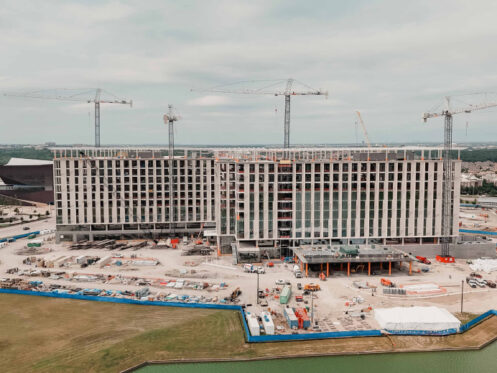The Affordable Care Act crashed the party that is public health care with a moxie few could comprehend, shaking up the rules, rendering the script almost unrecognizable to old-schoolers who prided themselves on fluency in “the way it is.” Paper-based medical records? Over. Enter Electronic Healthcare Records. Utilitarian composite roof views from patient windows? Cold, sterile hospital environments? Phasing out and ending. Enter KPost Company and evidence-based design concepts.
New healthcare mandates have rushed the scene, forcing systemic changes unprecedented in the last 50 years, since Medicare’s inception in 1964. Patients have found themselves increasingly relevant to the newly imagined status quo while veteran doctors circling the retirement question have found ample reason to ghost, dignity intact. The changes decidedly favor patients’ opinions, as evidenced by the push for patient satisfaction surveys, which impact hospitals and their ability to receive full compensation from the federal government. Healthcare reform brings with it encouraging glimpses of the future (think: well-designed hospital environments, improved patient experiences, streamlined records) and a bevy of scientific research that indicates the way forward, while complicated, promises more positive patient outcomes than ever before.
Patient Satisfaction Surveys: Environment Trumps All Else
“Healthcare reform has mandated green roofs for new construction projects. We did one recently for an oncology ward here in DFW. A local architect provided a great spec. The cancer patients looked out onto nothing. We combined astro turf with container gardens to transform their roof view into something truly spectacular,” said Keith Post, President of KPost Company, a commercial roofing company featuring more than 270 employees, with 44 specialized crews, and two employees focused upon hospital design concepts.
In July 2014, The New York Times ran a story that truly encapsulates the shift toward green roofs and softer environments in response to patient feedback and research findings. The hospital, The University Medical Center of Princeton, New Jersey, developed and tested out a model patient suite, measuring patient experiences of everything from bed position to sink location; noise exposure to sleep disturbance; outside window views to direct sunlight exposure. The model suite residents reported more satisfaction with the hospital food and nursing care than their counterparts in the standard rooms, even though neither the food nor the nursing staff varied between the two groups.
Patients in the enhanced room ordered, on average, 30% less pain medication than their counterparts. Patient satisfaction rates soared from 61% to 99% following the hospital’s eventual move to a new facility featuring rooms designed like the model one. What changed, aside from patients’ perceptions of pain? The environment, the layout, the access to sunlight, and a scenic view out the window.
Under the new healthcare mandate laws, hospitals are penalized if too significant a proportion of patients report a negative experience or rate the hospital poorly.
Patient satisfaction with a hospital is largely NOT necessarily correlated to the quality of medical care received there, or by the resolution of the health problem. It boils down to environmental factors like the messages conveyed by the doctors, the kindness of the nurses and staff, as well as the physical hominess and comfort of the hospital environment‘s design. Many hospitals have even resorted to hiring “Chief Patient Experience Officers.”
Florence Nightengale Was Onto Something: The View From The Patient’s Room
“It is a curious thing to observe how almost all patients lie with their faces turned to the light, exactly as plants always make their way towards the light; a patient will even complain that it gives him pain “lying on that side.” “Then why do you lie on that side?” He does not know,–but we do. It is because it is the side towards the window… count how many sick you ever saw lying with their faces towards the wall.” – Florence Nightengale
KPost Company specializes in Dallas commercial roofing jobs that promote aspects of environmental and landscape design for hospitals. The first study proving patient exposure to direct sunlight significantly improved patient outcomes happened all the way back in 1984. Progress sometimes takes a while for organizations to embrace. Sunshine and green space outside patient windows reduce patients’ feelings of isolation, loneliness, and stress. Detailed landscape designs atop the previously vast, empty expanses of roof make sense from both a design and human perspective.
“Sure, these hospitals face a government mandate to install green roofs but they truly love them when we are done,” says Aileen Struble, Senior Estimator at KPost Company. “I have a background in design, so I have been delighted to partner with hospitals across the metroplex to engineer unique roofscapes made from the highest quality materials. We are after longevity and beauty here. Form as well as function.”
KPost Company: Coaxing Hospitals Back to the Dance Floor
Hospitals reap rewards under the current laws if patients rate their experiences highly, but they will increasingly suffer financial setbacks when patients express dissatisfaction. They must be vigilant about scheduling commercial roof assessments regularly, keeping up with preventative maintenance, and choosing a commercial roofing partner that will not leave them languishing on the sidelines. Hospital rooms cannot be easily vacated due to leaks or other roof structure problems, so they must stay on top of all aspects of roof care.
“The moral to this story is simply, ‘Don’t let the patient surveys come back to haunt you.’ Keep your hospital looking beautiful and your rooftops meticulously maintained. There is no place for a leak in a hospital. Ever,” says Post.
There is no substitute for a well-designed commercial roof system, cut from the highest quality materials and conscientiously applied, particularly when the client desires the highly specialized roofscape options inherent to the hospital beautification projects cropping up across the country. Laying astro turf and planning around the electric and air conditioning systems that also reside atop the roof requires a commercial roofing company of the highest caliber.
“The law states that the environment has to be pleasing and soothing to expedite healing. We do more than that. We offer full service roofing and create beauty where there was neglected space,” says Dalila Vallejo-Newhard, KPost Company business development representative.
There is no telling which other sweeping changes will breeze onto the healthcare scene, ushering in yet another new era of patient care, but the guiding principles of quality craftsmanship, specialty waterproofing, leak repair, lightweight concrete maintenance, full-spectrum building envelope services, and preventative maintenance will not budge one iota. Dallas commercial roofing contractors with the advanced skillset to rise to the new challenges of green roofing will continue to be in demand as hospitals scramble to keep pace with the healthcare arena’s many mandates.

